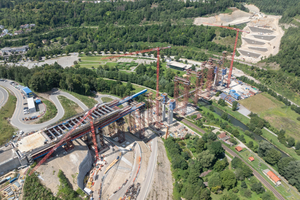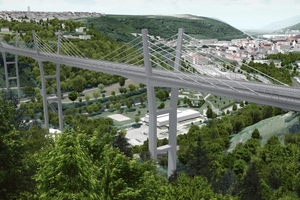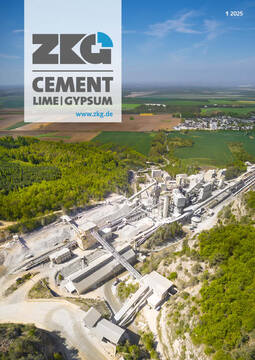Gateway to the Black Forest
Cable-stayed bridge near Horb with major structural challenges
The cable-stayed bridge over the Neckar valley will provide important relief for traffic in and around Horb as well as a stronger connection between the Freudenstadt and Upper Neckar regions. The construction project is characterized by high structural and logistical requirements, a slim bridge design and the use of innovative materials. Heidelberg Materials is providing support with special types of cement and comprehensive hardened concrete tests.
When the foundation stone for the construction of the 667-m-long bridge was laid in April 2023, it was jokingly referred to as the Black Forest Gate Bridge. This gateway to the Black Forest will bring the Freudenstadt and Upper Neckar regions closer together. However, before the first vehicles can roll over the bridge, which is 70 m high in places, there are still a number of tasks to complete, as the construction project is highly complex. “This starts with setting up the construction site. As the main areas are located in the Neckar floodplains and therefore in an area at risk of flooding, we have to take special protective measures. In addition, work platforms and access routes have to be built into the slope in the southern and northern areas so that cranes can be set up and concrete mixing and other vehicles can supply the construction site with materials,” explains project manager Markus Jahn, site manager at PORR GmbH & Co. KGaA. For example, several concrete pumps are being used simultaneously for the concreting of the superstructure beams to ensure that the 800 m³ of concrete can be poured per day for certain concrete sections.
Hardened concrete tests by Heidelberg Materials
When building the bridge, stable statics of the structure are elementary and therefore also require special concrete properties. “Special concrete properties are required for a stable structure. When building bridges, these properties must comply with the strict specifications of ZTV-ING, which go beyond the requirements of conventional construction projects. On behalf of our long-standing high-performance partner, BNS Betonverbund Nordschwarzwald GmbH & Co. KG, we have successfully carried out hardened concrete tests,” explains Dr. Egor Secrieru, Deputy Head of Engineering & Innovation. “Such control tests are crucial for concrete formulations that have to meet specific requirements in terms of compressive strength and modulus of elasticity.”
Cement types as a guarantee for compressive strength
Ultimately, the types of cement on which the recipe is based guarantee the compressive strength. “We used CEM III/B 42.5 N LH/SR (na) cement from the Lengfurt plant for the piers and CEM II/A-LL 42.5 N from the Schelklingen plant for the top slab,” explains Markus Siemund, Consulting & Sales for the South-West sales region. During the site inspection, everyone involved was able to get an idea of the construction progress - and of the quality of the materials used. “You could see that the concrete used looks flawless and has no pores or cavities,” confirms Siemund.
Structural implementation with high requirements
Overall, the structural implementation was anything but trivial, assures Jahn. This is not least due to the high demands placed on the design of the bridge. Once completed, the cable-stayed bridge will span the Neckar valley as a six-span structure. To ensure that the cable-stayed bridge blends in well with the landscape, the superstructure, as well as the piers and the V-shaped, up to 90-m-high pylons, have a slender design. This, in turn, can only be achieved with special construction measures. The pile foundation extends up to 70 m deep into the calcareous, karstic subsoil and the superstructure must also be stabilized.
BNS Betonverbund Nordschwarzwald GmbH & Co. KG
CEM II/A-LL 42.5 N for the upper slab, Schelklingen plant, Heidelberg Materials






